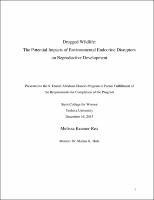Please use this identifier to cite or link to this item:
https://hdl.handle.net/20.500.12202/4165Full metadata record
| DC Field | Value | Language |
|---|---|---|
| dc.contributor.author | Kramer-Rex, Melissa | - |
| dc.date.accessioned | 2018-11-08T20:31:32Z | - |
| dc.date.available | 2018-11-08T20:31:32Z | - |
| dc.date.issued | 2015-12 | - |
| dc.identifier.uri | https://hdl.handle.net/20.500.12202/4165 | - |
| dc.identifier.uri | https://ezproxy.yu.edu/login?url=https://repository.yu.edu/handle/20.500.12202/4165 | |
| dc.description | The file is restricted for YU community access only. | - |
| dc.description.abstract | The growing use of oral contraceptives and hormone therapeutics gives rise to the concern that estrogenic and progestogenic compounds are present in wastewater at concentrations that may affect aquatic species. This study showed that wastewater effluent produced by the Charleston Water System facility at Plum Island, when concentrated 100 times, contains endocrine active compounds that activate the human nuclear estrogen and progesterone receptors in an in vitro transactivation assay system. This may provide a mechanism for the alterations in secondary sex characteristics that have been reported in fish exposed to wastewater effluent from other locations. Some synthetic hormones have also been found to be bioaccumulated in teleost fishes. There is, therefore, potential for humans to be exposed to these endocrine active compounds through consumption of these fishes. The current study evaluated the effects of neonatal exposure to progestogens on the regulation of reproductive development by estradiol (E2) stimulation in adults, using mice as a model. Quantitative PCR analysis of target genes from mice treated with the synthetic progesterone 17α-hydroxyprogesterone caproate (17PC) as neonates suggested that developmental exposure to progestogens might decrease sensitivity to E2 at the uterine transcriptome level, and showed patterns similar to microarray data that revealed that perinatal exposure to 17PC suppressed uterine E2 sensitivity in the adult. These data indicate a need for further exploration of the subject. | en_US |
| dc.description.sponsorship | S. Daniel Abraham Honors Program | en_US |
| dc.language.iso | en_US | en_US |
| dc.publisher | Stern College for Women | en_US |
| dc.rights | Attribution-NonCommercial-NoDerivs 3.0 United States | * |
| dc.rights.uri | http://creativecommons.org/licenses/by-nc-nd/3.0/us/ | * |
| dc.subject | Wildlife as food --Contamination --United States. | en_US |
| dc.subject | Fishes --Effect of pollution on --United States. | en_US |
| dc.subject | Endocrine disrupting chemicals in water --Environmental aspects --United States. | en_US |
| dc.subject | Reproductive toxicology --Environmental aspects --United States. | en_US |
| dc.subject | Human reproduction --Effect of chemicals on --Environmental aspects --United States. | en_US |
| dc.subject | Water --Pollution --Environmental aspects --United States. | en_US |
| dc.subject | Water-supply --Health aspects --United States. | en_US |
| dc.subject | Oral contraceptives --Environmental aspects --United States. | en_US |
| dc.subject | Hormone therapy --Environmental aspects --United States. | en_US |
| dc.subject | Endocrine toxicology --Environmental aspects --United States. | en_US |
| dc.subject | Estrogen --Environmental aspects --United States. | en_US |
| dc.subject | Progestational hormones --Environmental aspects --United States. | en_US |
| dc.title | Drugged Wildlife: The Potential Impacts of Environmental Endocrine Disruptors on Reproductive Development | en_US |
| dc.type | Thesis | en_US |
| Appears in Collections: | S. Daniel Abraham Honors Student Theses | |
Files in This Item:
| File | Description | Size | Format | |
|---|---|---|---|---|
| Melissa-Kramer-Rex.pdf Restricted Access | 840.01 kB | Adobe PDF |  View/Open |
This item is licensed under a Creative Commons License

